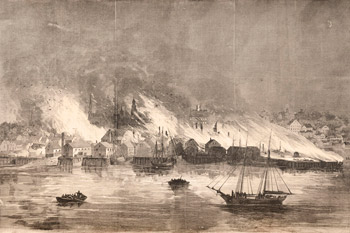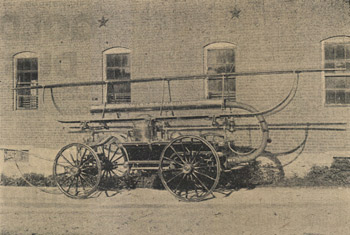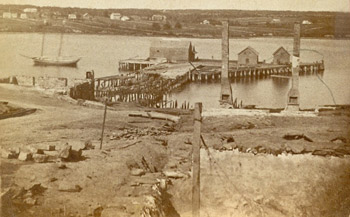The Great Fires of Belfast
by Tom Seymour

The 1865 Belfast fire took place on October 12. The fire swept along the waterfront, downtown and residential areas driven by northerly winds destroying 125 buildings in a 22-acre area. William M. Hall of Belfast drew the sketch for Harper’s Weekly Magazine. The engraving appeared nationally in the November 4, 1865 edition. Courtesy of Maine Historical Society
Most every long-established city or town center has had its share of fires over the years and Belfast, Maine, has perhaps had even more than its share.
Early on, waterfront fires were common. Here, hay and other extra-flammable products were stored for shipping. The years 1865 and 1873 both saw the Belfast waterfront going up in flames. The Telegraph Building and American House fires of 1885 rocked the city. The Phoenix Row fire in 1887 was a disaster of huge proportions and the Crosby Inn fire of 1896 destroyed what was then a state-of-the art luxury hotel. Then in 1899, the Pierce’s Block fire must have seemed to residents that such huge conflagrations had become the norm.
There were other fires, of course. Belfast began keeping records of fires, their causes and eventual outcomes, in 1820. But the fires outlined in this article are among the most notable, either for extent, duration, or both.

The Washington #5 pumper was purchased by Belfast in 1865. “The “new” engine, the Washington, which had been used a short time, was procured at Charlestown, Mass., and arrived here November 18. To defray these expenses, the sum of three thousand dollars was voted, and raised by loan. It is a “hand tub,” hand-drawn pumper, suction engine type.” – Williamson’s History of Belfast. Courtesy of Belfast History Museum
Great Fire of 1865
Picture dawn breaking after an all-night fire that consumed 125 structures and that covered 20 acres. That was the end result of a fire, unknown origin, that began on the Belfast waterfront in the boat shop of James C. Lewis at 10:30 p.m. on October 12, 1865.
According to Williamson’s History of Belfast, a “moderate breeze was blowing from the north.” The shop was totally ablaze even before an alarm could be sounded. By then, flames had spread, assisted by the wind, to hay-filled storehouses behind the boat shop. From that point there was no stopping it as flames leaped from structure to structure, marching up streets like an invading force, firing buildings on both sides.
Besides the wind fanning the flames, it was low tide and the reservoirs, otherwise available to provide water for fire fighting, were at their annual fall low. Also, only one engine was available to pump what water there was, the other being not operational at the time.
Firefighters used various means in their attempt to halt the spread of the fire. Several buildings in the apparent path of the blaze were purposely demolished, but to no avail. In time, a fire engine from nearby Searsport arrived and promptly went to work in spraying water on the inferno.
And still the fire spread. The people engaged in fighting the fire had one more option and they took it. They blew up Dr. Sylvester’s store. This had the desired effect and had it failed, the whole of Belfast would have wound up a huge field of charred rubble.

Map outlining the perimeter of the Belfast fire of 1865. Prevailing winds out of the north (left on this map) drove fires southward through the town of wooden buildings. Courtesy Belfast History Museum
By 7 the next morning, the fire was finally under control. The chaos wreaked by not only the loss of buildings, businesses and residences alike and by those, fearing the advancing flames who moved all their belongings and store contents out of harm’s way, cannot be fully appreciated. At a meeting of city officials immediately after the fire, it was determined to upgrade and enlarge the fire department. Hydrant #2, the engine that was out of commission during the fire was repaired and another engine, the Washington, was purchased from Charlestown, Massachusetts.

Remains of Simpson’s Wharf after the Belfast fire of 1873. Spring St., left center where it intersects Front St. Remains of chimneys center right, building foundation foreground right and center left. Simpson’s Wharf half burned center. Courtesy Belfast History Museum
Weeping and Homeless
Again according to Williamson’s, the fire that began on a wharf at the foot of Main Street around 2 p.m. on August 24, 1873 and swept along the waterfront, up city streets and even consumed a vessel sitting on the stocks, was the third worst fire in Maine next to the fire caused by the British bombardment and resulting fire of Falmouth (Portland) in 1775 and the great Portland fire of 1866.
This fire, fanned by fierce winds, was more aggressive than the 1865 blaze. Warehouses, wharves and stores of dry goods, including coal, went up like tinder and continued to burn with an unrelenting vigor.

Outline of the Belfast fire of 1873: Just eight years after the fire of 1865 another, near repeat, devastating fire burned closer to the waterfront. Partially burned Simpson’s Wharf – upper right. Some of the rebuilt buildings from the 1865 fire burned again in 1873. Bluster evening winds drove embers onto wood shingled roofs feeding the momentum of the blaze. Terrified residents were driven from their burning homes and into the streets until dawn revealed the extent of the destruction. Courtesy Belfast History Museum
Fire companies from nearby towns responded quickly. Searsport, with their engine, were on the scene early on. Castine sent their fire engine over on a revenue cutter recruited for that purpose and a steam tug, which was anchored off Fort Point came and threw water on the flames from every possible angle. Additionally, a hose company from Bangor accompanied that city’s steam fire engine on a special train to Belfast. The Bangor unit devoted its time to keeping two burning piles of coal at bay.
By 6 p.m., the fire was contained and the danger of it spreading ended. The aftermath of this fire presented a surrealistic scene. A total of 86 buildings were lost, 53 of which were people’s houses. 75 families were rendered homeless and Miss Rebecca Prentiss died when in a fit of shock, she ran back into her burning High Street house.
As piles of corn and coal continued to burn amid smoking ruins of houses, piers, wharves, warehouses and a 500-ton brig sitting on the stocks, women and their now-homeless children sat among the ashes of their former homes and wept. A more pitiable scene cannot be imagined.
Later, Belfast appealed to the world for financial assistance. Contributions quickly flowed in from home and abroad. The community turned out with not only financial aid, but also food, clothing and building materials. The great outpouring of aid and sympathy was felt with deep gratitude by the unfortunate citizens of Belfast.
1885 Blaze
The great fire of 1885 was considered the most disastrous blaze since the terrible fire of 1873. In it, 16 buildings were totally destroyed. Also, two persons and 21 horses died. The men who perished were Elmer Wesley and John Casey, workers in a stable who were considered responsible for the fire. The men, both smokers, slept in a hayloft and careless smoking habits are attributed as the fire’s cause.
Soon after the stable caught fire, flames reached out and caught the American House, a hotel, and its accompanying stables and also, the Telegraph building and a store on Beaver Street. The fire continued along, taking out stores, sheds and carriage shops.
Phoenix Row
Smaller, but still destructive fires continued to plague Belfast. And then on June 12, 1887, the Phoenix Row, a block consisting of six contiguous stores located on High Street, caught fire.
The loss of Phoenix Row, besides being a huge financial upset to businesses owners and other renters, represented a cultural loss as well. The Phoenix Row Block, built in 1824, was one of the oldest structures in Belfast.
But this fire resulted in something else completely unforeseen. The Boston Insurance Exchange informed Belfast that unless the city purchased a steam-powered fire engine (up until that time Belfast used hand-pumped engines), their policies would either be cancelled entirely or the rates doubled. The insurance companies had had enough. Belfast promptly rented a steam-powered fire engine at a cost of $50 per month.
Crosby Inn
The Crosby Inn opened for business on June 1, 1889. This sprawling, palatial hotel was the pride of its owners and also the visiting public. The inn boasted 65 rooms, complete with steam heat, piped-in gas for cooking and water courtesy of Belfast Water Works.
But the great hotel was, like all the other wooden buildings in and around Belfast, subject to fire. And on January 4, 1896, fire broke out in the attic.
The inn was prepared for such an emergency and had fire hoses in place that were quickly turned on to douse the flames. But the hoses produced no water. It was reported that if water had been forthcoming, the fire would have easily been extinguished. By the time firefighters arrived the roof and tower were in flames. But even then, the cards were stacked against the future of Crosby Inn.
The temperature hung at the zero mark and a gale wind pummeled the inn from the west. And then when firefighters tried to turn the hydrants on, they experienced great difficulty. A Mr. Morrison, tending a hydrant in front of the inn, later testified that he had to physically jump on the device and later, had to resort to an axe to coax the handle into the prerequisite number of turns.
Despite finally fully opening the hydrants, only a little water came forth, and that was a weak, thick, muddy stream that only reached up to the second floor. But there was no shortage of water at the source, since the city standpipe contained more than an ample supply and this was noted 90 minutes previous to the fire.
Finally, the water, such as it was with its components of rocks, mud and gravel, took its toll and it appeared that the fire had subsided. But that was illusory, since as the fire lessened in one place it appeared in another with renewed intensity. Then, as people were removing their belongings from the doomed building, an explosion of unknown origin occurred in several rooms, blowing the door off its hinges in one room and knocking a man down. The man managed to escape without further injury.
In the end, only the annex, the kitchen and one wall of the north wing remained standing. The Belfast Age, a local newspaper, reported that after the fire, drunkenness abounded all around town and police were kept busy breaking up fights.
But another ugly side of human nature was also revealed by the Crosby Inn fire. Looting took place, something unheard of until this time. Later, a sheriff’s inquest failed to determine the origin of the fire and ruled it as an unknown cause.
1899 Fire
The last year of the 19th century went out with the usual number of house fires. But prominent among fires for that year was the fire that burned down the Pierce Block on the corner of Main and Franklin Streets.
The lower section of the block held three businesses, which included a bakery, billiard parlor and a restaurant. The upper section was home to Belfast Age Publishing Company. The newspaper’s files from the past 45 years were destroyed, a great loss to the community.
None of the occupants of the Pierce Block went back in business. The fire had put an end to them, once and for all.
And yet, in the coming years, Belfast rebuilt itself and now the town sits, as it were, on the ashes of its predecessors. Fire, though devastating, failed to dampen the spirits of this small coastal Maine city. And so today Belfast continues, albeit with safer fire detecting and firefighting equipment.
Many thanks go out to Megan Pinette of Belfast Historical Society and Museum for assistance in compiling data for this story.
